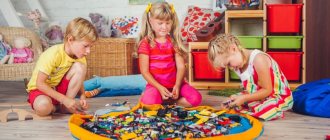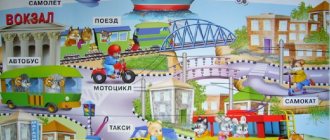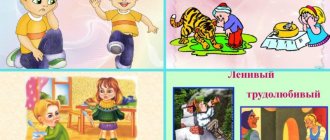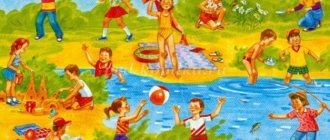Many children who are not even two years old can already speak well. Conversely, sometimes two-year-old toddlers master communication skills much more slowly than younger children. Therefore, it is necessary and important to work with your child - special games for speech development can help.
Source: instagram @davaipoigraem_kazan
Do not forget about the important rules that should be followed during speech development classes.
Norms of speech development at the age of 2-3 years
Speech development occurs between the ages of 0 and 3 years. Normally, this happens in several stages, and parents should understand them. In the period from 0 to 1 year, onomatopoeia and babbling become more active in the child’s speech. By the age of one year, the first words appear; there should be from 10 to 25 or more. The baby understands spoken speech, follows simple instructions, and knows the names of objects in the surrounding space. By the age of two, coherent speech is actively developing. Words form a sentence. In the third year of life, the baby begins to be interested in the world around him, and his vocabulary is actively expanding. Phrases become detailed and grammatically correct, and word creativity appears.
Lesson on speech development at a preschool educational institution
Rule #1: understandable!
The first of them says: start developing your child’s speech based on his existing skills. This is actually a very important point!
"Repeat after me"
Usually, by the age of one year, children already pronounce at least individual syllables or use onomatopoeia in communication. This is enough to teach the very first words. Before starting the game, select those syllables or sounds that the baby already pronounces well enough.
- Take, for example, the word “drink.” The child may say the word “drink” or use the syllable “pi”. Prepare toys, substances, objects whose names contain this syllable. Sand, a toy pirate, pajamas, a pistol, a children's piano, and a bright pyramid will do.
- Sit comfortably, lay out these items and tell your baby: “What do you like to do (pointing to the bottle), drink? Right! What do you want?" Let the baby ask for a drink himself. Give him some water and immediately put the bottle away.
- “Look who came? Bear. And the bear has pajamas. Pajamas. Say with your mom: “Pajamas.”
- "Oh! What kind of instrument? - and press the baby’s finger on the key of the children’s piano. “Piano, piano, let’s do it again!”
If there is something that particularly interests your baby, stop there. Repeat new words several times. For the next lesson, select words with a new syllable that the child pronounces independently, and toys to go with them. When learning new words, return to the ones you have already mastered every two days.
Source: instagram @alexeeva.elena0812
"Lullaby"
The exercise helps the baby pronounce the sound “a-a-a”. This game is good to play in the evening. In addition to its calming effect, it stimulates the first vocal reactions. Play a slow lullaby that is best known to your baby, and chant the sound “a”, “a-a-a” (at different pitches).
Encourage your child to pronounce the sound “a”. Your face should express emotion and draw attention to your articulation. Ask your child to sing for you. Use his favorite toy: a bear or a doll and sing the same sound “a-a-a” with him. Let the names of the selected toys or their names begin with the sound “a”.
"My Encyclopedia"
The game helps expand the child’s passive vocabulary and also serves to develop the articulation of sounds.
- Select pictures in advance (they should be large enough, clear, bright and preferably the same size) on topics, for example: birds, flowers, animals, trees, cars, etc. Within the topics, select words with syllables or sound combinations accessible to your child. Place your baby opposite you, take the cards in your hand, but try not to block your face. The child must see both the picture and the mother’s face.
- When you pronounce words, to more strongly attract the baby's attention to your articulation, it is best to use your index finger, pointing it at your chin as you pronounce each new word.
- You must articulate expressively enough to attract the baby’s attention both to you and to the pictures.
- In each subsequent lesson, try to use a new topic. After some time, come back to review topics already covered.
Source: instagram @non_anonymoms
"First Gallery"
Stimulates the child's first vocal reactions. You will need bright illustrations - images of animals in A4 format.
- To begin, prepare 3-4 pictures and hang them on the wall of the children's room. For subsequent games, pictures are either changed or added. They should be hung at the child’s eye level.
- Turn on some nice music. If you have hung, for example, images of a duck, a kitten, a cockerel and a hen, then you can chant the following text: “Our ducks in the morning are quack-quack, and the cat purred - meow-meow-meow, the cockerel woke up and screams - ka-kaa -ku, the chickens are cackling - co-co-co.”
- It would be a good idea to prepare a pointer for the game, it will be more convenient. Say the words and point to the corresponding picture.
Methods for diagnosing developmental delays
Speech development does not always follow the planned scenario. Increasingly, one can observe its absence or obvious violations in sound pronunciation and grammatical structure. For a complete diagnosis of speech development, parents should seek advice from a speech therapist. The specialist will analyze the level of development of speech components: sound pronunciation, vocabulary, grammar, speech coherence.
During the examination, the speech therapist will offer the child to play with toys: pyramid, inserts, Matryoshka. During the process, a specialist will be able to identify deviations that manifest themselves in different ways. Violations of sound pronunciation are perceived by ear, just like underdevelopment of lexico-grammar.
For your information! One can often observe a picture of lack of speech at a given age.
Diagnosis and consultation with a speech therapist
Progress of the game. The players stand in a circle. The leader has a baton-relay. He
pronounces a word and passes the baton to the person standing next to him
to kid. He must choose the appropriate action word and quickly
pass the wand on. When the baton returns to the leader, he asks
a new word , but sends the stick in a different direction. If somebody
finds it difficult to name a word or chooses an inappropriate word , he is given
penalty point. After a player has accumulated three penalty points, he
leaves the game. The one who has less at the end of the game wins
penalty points.
Interesting didactic games for speech development
In modern pedagogy, speech games are classified depending on the component they are aimed at developing. Thus, developmental and formative are distinguished:
- sound pronunciation;
- phonemic processes;
- lexico-grammatical structure;
- coherent speech.
Didactic games for pupils of the younger group are aimed at developing several speech components at the same time. They are actively used by kindergarten teachers.
Note! Many manuals and educational games can be found on online resources dedicated to raising children.
For example, two games to understand what their essence is:
- "Turn into an animal." The goal is the formation of onomatopoeia, prosodic components of speech. The teacher hands out wreaths with images of animal faces to the children and asks them to depict how the animal makes its voice. Then it is suggested to repeat it quietly/loudly, slowly/fastly, angrily/cheerfully. Such a game can turn into a theatrical show.
- "Magic chest" The goal is the formation of phonemic perception of non-speech sounds. The teacher invites the children to listen to the sounds of various musical toys (tambourine, drum, harmonica, bell) and remember how they sound. Then he hides them from the eyes of the pupils and plays each one in turn, and the children must guess what it sounds.
Exercises for home practice on pronouncing the letter P for children
Rule #2: have fun!
Stimulating a child’s independent speech should always be emotionally charged. During games, the child should be surprised and happy. Then the baby will immediately begin to repeat new words after you.
"Talking Ball"
- Sit opposite your child and take the ball. Throw it to the baby and cheerfully say: “Ah!” The baby, throwing the ball back to you, should also say “Ah!” Encourage him to do this.
- Then you can pronounce a sound, syllable or word that the child himself can already pronounce, for example, “di!” - and he will cheerfully say “di!”, throwing the ball back to you.
- Then offer your onomatopoeias. When throwing the ball, say “meow!” The baby must throw the ball back, saying “meow!” Use onomatopoeia “gaga-ha”, “quack-quack-quack”, “mu-mumu” and any others.
- If your baby takes the initiative and pronounces his own syllable, be sure to support him by repeating the sounds or words after him. Let him become the main one in this game!
Source: instagram @alicekuly
"Sound Charge"
- Choose fun, rhythmic music: You will need to do some exercise while pronouncing sounds, such as vowels.
- Let's say, when saying “ah-ah”, you clap your hands loudly in front of your chest, saying “o-oh” - clap above your head, saying “y-y” - clap your knees, saying “uh” - show your horns, “oooh” - blow into your fist.
- The main thing is that the child likes this music, and the exercises that he will do are accessible. Then the baby will happily join in such speech gymnastics, practicing correct sound pronunciation.
"Talking toys"
- Take several toys that “speak” with the voices of animals (for example: a pig, a dog, a tiger, a cat, an elephant).
- Place them in front of your child and turn on each toy in turn. Click on the pig - the toy emits a loud “oink-oink-oink”, click on the tiger - he roars “rr-rr-rr”. And so on in turn with each.
- After the animal toy makes a sound, repeat it in your speech so that the child remembers it from your lips.
- Then invite him to play with all these toys, but with a condition: for this you need the baby to call them to him.
- Invite your baby to call the animals using the same sound that the toys themselves make. For example, how to call a pig? - "Oink oink oink". Emotionally support any vocal reaction that the child makes, this is very important!
- When the baby says something, let him receive a kind of reward: this could be a game with an animal, the baby can pet it, dance with it, and so on in turn with each of the animals.
- After such an exciting mini-lesson, put the toys away and take them out next time only during educational activities.
Source: instagram @alena_rudy
"Home Theater"
The game trains speech perception and the ability to understand a simple plot. Place the baby at the children's table and prepare toys for putting on the hand (glove dolls). Having put the dolls in your hands, act out a simple story in front of your child. For example, let's take a cockerel and a fox. First the rooster appears. Let’s say “kook-ka-re-ku” for him, show him how he pecks the grains, you can even sprinkle some beans on the table for authenticity. Then a fox suddenly appears, the rooster immediately runs away in fear, and the fox catches up with him (unsuccessfully). The baby will listen carefully if the story is short and emotional. The performance should not last longer than 1 minute.
"Who's there?"
The activity develops the child’s speech hearing and also teaches the baby to quickly respond to sound. Place your baby in a high chair and place a screen in front of him. Prepare toys in advance, such as a duck, cat and dog. Without showing the toy, suddenly say: “Quack-quack-quack.” As soon as the child's attention is attracted, show the duck from behind the screen.
The baby will immediately pull his hands towards her, at this moment ask him to call the duck, also saying: “Quack-quack.” Be sure to hand this duck to the baby and let him play with it. After a couple of seconds, say with a different intonation behind the screen: “Meow, meow.” The baby should look at the screen again, after 1-2 seconds show the cat and also give it to him. While the baby is playing with the cat, say loudly: “Woof-woof” - and hand him the dog.
Source: instagram @pedclin_ru
"Smile at the Frog"
Imitation is the main component of your baby’s future mental activity. With the help of this game, the speech organs involved in sound articulation are well trained.
- So, pull a frog toy onto your hand that can open its mouth wide. “Little one, a frog visited you - qua-qua-qua, give her your smile - yes, yes, yes.” During this game the child should smile, so ask him to smile at the frog.
- "Amazing! Now show the frog how serious you are! Well done! And again give the frog a joyful smile. What a smart girl!”
During such games, try to surprise and entice the baby, and soon the desired result will definitely be achieved!
Progress of the game. The presenter explains what the children will have to finish
sentences that the presenter will begin to speak using the word “because
What". You can select several options for one start
proposals, the main thing is that they all correctly reflect the reason
events described in the first part. For every correctly completed
continuation players receive a chip. The one who collects wins
more chips.
"Unravel the Words "
Goal: learn to compose sentences using these words .
Speech game with kids 11. Names of baby animals
With the help of this poem, you can introduce your child to the names of baby animals and activate these words in speech. Then the end of the poem will sound like this: “And he waits, who will come first? A horse with a foal or a cow with...? (the kid finishes: with the calf). A cat with a kitten or a chicken with... ? (the kid finishes: with chicken). A hedgehog with a hedgehog or a squirrel with...? With whom? (the kid says: with a little squirrel). Turkey with turkey or duck with..? With whom? The kid says the answer: “With a duckling.”
The best way to make this game is to stage it using pictures of little animals and their babies who come for porridge. If the kid guessed correctly, then we open and show him the corresponding picture (a chicken has come running, a duckling is walking)









